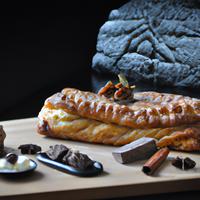
1 serving (100 grams) contains 350 calories, 5.0 grams of protein, 18.0 grams of fat, and 45.0 grams of carbohydrates.

Log this food in SnapCalorie

Nutrition Information
Calories |
833.3 | ||
|---|---|---|---|
% Daily Value* |
|||
| Total Fat | 42.9 g | 55% | |
| Saturated Fat | 11.9 g | 59% | |
| Polyunsaturated Fat | 0 g | ||
| Cholesterol | 23.8 mg | 7% | |
| Sodium | 595.2 mg | 25% | |
| Total Carbohydrates | 107.1 g | 38% | |
| Dietary Fiber | 4.8 g | 17% | |
| Sugars | 47.6 g | ||
| protein | 11.9 g | 23% | |
| Vitamin D | 0 mcg | 0% | |
| Calcium | 47.6 mg | 3% | |
| Iron | 3.6 mg | 20% | |
| Potassium | 190.5 mg | 4% | |
* Percent Daily Values are based on a 2,000 calorie diet. Your daily values may be higher or lower depending on your calorie needs.
Food Attributes
Source of Calories
About Beaver tail pastry
BeaverTail Pastry is a popular Canadian treat originating from Ottawa, combining deep-fried dough and sweet toppings for a satisfying indulgence. Shaped like a beaver’s tail, the pastry is made fromwhole wheat flour, milk, yeast, sugar, and eggs, forming a dough that is stretched and fried until golden brown. It is traditionally topped with cinnamon and sugar, though variations include chocolate, fruit, or maple syrup. While the inclusion of whole wheat flour adds some fiber, the pastry is high in refined sugars and fats due to the toppings and frying process, which can contribute to a calorie-dense snack. Healthier versions can be made by baking instead of frying or using more nutrient-rich toppings like fresh fruit. The BeaverTail is celebrated for its comforting flavor and cultural significance within Canadian cuisine despite being a treat best enjoyed in moderation.



